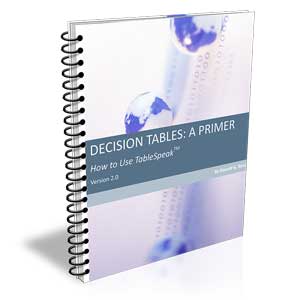Capturing the Essence of Concepts: Guidelines for Building World-Class Business Glossaries
Extracted from: How to Define Business Terms in Plain English: A Primer, Ronald G. Ross, 2016 (free download). http://www.brsolutions.com/b_ipspeakprimers.php
There are various schools of thought about how to define terms, some arising from professional terminologists and academia. But those approaches are often relatively arcane and not well-suited to everyday business practice.
So ConceptSpeak™, the BRS approach, stays with common dictionary practices. They are perfectly adequate for your needs. By 'dictionary' I mean natural language dictionaries of course, not any kind of dictionary arising from IT (e.g., data dictionaries).
Definitions with subtle IT or 'data' bias are an anathema to effective communication with business partners. Good business definitions are oriented to what words mean when used by real business people talking directly about real business things.
Guideline 1. The definition of a term should express the essence of the concept, not its purpose, function, or use.
Discussion: Things can have multiple purposes, functions, or uses, and those things may vary in different contexts or over time. The core essence of a concept, in contrast, varies little or not at all viewed from different perspectives or at different times. Effective business communication requires focusing on core meaning.
Example: business requirement
Poor definition: a need or demand required of a solution by some stakeholder(s) which will serve as a bridge to system design
The phrase which will serve as a bridge to system design in this definition explains one purpose of a business requirement. That purpose may be paramount to some people, but perhaps not to others. For example, business requirements might be used by business staff to prepare for training of workers or new hires. The business staff might not care about, or might even disagree with, the expressed rationale.
Explanation of purpose, function, or use should be removed from definitions. If worth retaining for future reference, it can be given as separate note(s) for the term's entry. That way the definition itself can serve equally well for multiple audiences, each with different ideas or insights about the relevance of the concept.
Revised entry:
business requirement: a need or demand required of a solution by some stakeholder(s) in the business
Note: Business requirements often serve as a bridge to system design.
Guideline 2. A definition should be clear about whether the concept being defined is an individual or a general concept.
Discussion: Definitions are often required for individual things, especially when the individual is abstract or intangible rather than a particular person or place. Special caution should be exercised for words that can be taken in the sense of either individual or general concept.
Example: observation
Poor definition: assessing a work environment as a means to elicit requirements
The intended meaning of observation could be either of the following:
- a particular method of eliciting requirements.
- a particular act or instance of using that method to elicit requirements.
Which is meant? The former meaning views observation as one particular method of eliciting requirements. As such it designates an individual, one particular thing. In the following definition note use of the, rather than a, to correctly indicate the thing is one particular individual (of the general concept method).
Revised definition 1: the method of eliciting requirements that is based on direct viewing of a work environment
The second meaning above views observation as an act where the given method is actually applied, presumably one act among many others of the same kind. In the following definition note use of an, rather than the, to correctly indicate the definition refers to any of many individuals. The kick-off word has also been changed from method to act or instance.
Revised definition 2: an act or instance of eliciting requirements that is based on direct viewing of a work environment
For further information, please visit BRSolutions.com
# # #
About our Contributor:
Online Interactive Training Series
In response to a great many requests, Business Rule Solutions now offers at-a-distance learning options. No travel, no backlogs, no hassles. Same great instructors, but with schedules, content and pricing designed to meet the special needs of busy professionals.











How to Define Business Terms in Plain English: A Primer
How to Use DecisionSpeak™ and Question Charts (Q-Charts™)
Decision Tables - A Primer: How to Use TableSpeak™
Tabulation of Lists in RuleSpeak®: A Primer - Using "The Following" Clause
Business Agility Manifesto
Business Rules Manifesto
Business Motivation Model
Decision Vocabulary
[Download]
[Download]
Semantics of Business Vocabulary and Business Rules